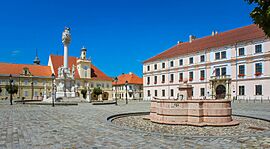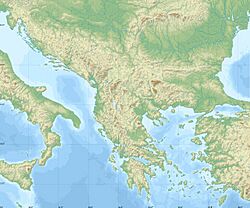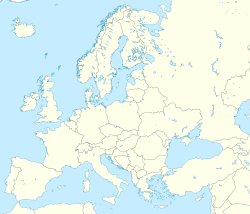Osijek facts for kids
Quick facts for kids
Osijek
|
|||
|---|---|---|---|
| Grad Osijek City of Osijek |
|||
|
From top, left to right: The City Guard in Osijek and Votive statue of the Holy Trinity with Palace of Slavonian General Command, Opus Arena, Osijek Co-cathedral with Ante Starčević Square, Archaeological Museum, Pedestrian bridge, Night view of Osijek's waterfront from the left bank of Drava river
|
|||
|
|||
| Nicknames:
Grad na Dravi (City on Drava), Nepokoreni grad (Unconquered City)
|
|||
| Country | Croatia | ||
| County | Osijek-Baranja | ||
| Area | |||
| • City | 174.9 km2 (67.5 sq mi) | ||
| • Urban | 59.1 km2 (22.8 sq mi) | ||
| Elevation | 94 m (308 ft) | ||
| Population
(2021)
|
|||
| • City | 96,313 | ||
| • Density | 550.67/km2 (1,426.2/sq mi) | ||
| • Urban | 75,535 | ||
| • Urban density | 1,278.1/km2 (3,310.2/sq mi) | ||
| Time zone | UTC+1 (CET) | ||
| • Summer (DST) | UTC+2 (CEST) | ||
| Postal code |
31000
|
||
| Area code(s) | 31 | ||
| Vehicle registration | OS | ||
| Climate | Cfb | ||
Osijek is the fourth-largest city in Croatia. In 2021, about 96,848 people lived there. It is the biggest city and the main center for business and culture in eastern Croatia's Slavonia region. Osijek is also the capital of Osijek-Baranja County. The city is located on the right bank of the Drava River, about 25 kilometers (15 miles) upstream from where it joins the Danube River. It sits at an elevation of 94 meters (308 feet).
Contents
City Name and Its Meaning
The name Osijek comes from the Croatian word oseka, which means 'ebb tide'. This name was given because the city is built on high ground. This helped protect it from floods caused by nearby swampy waters.
Throughout history, Osijek has had different names in other languages. This is because it was once part of the Habsburg monarchy and the Ottoman Empire. Some of these names include Eszék in Hungarian and Essek or Esseg in German. Its old Roman name was Mursa, or later Mursa Major.
A Look Back at Osijek's History
Early Beginnings
People have lived in the Osijek area since the Neolithic Age, which was a very long time ago. The first known groups were the Illyrians. Later, in the 4th century BC, Celtic tribes called the Scordisci arrived.
When the Romans took over the area, Osijek was known as Mursa. The Roman 7th legion protected the city and built a military camp there. They also built a bridge over the Drava River. In 133 AD, the Roman emperor Hadrian made Mursa a special Roman colony.
Mursa had a difficult history with many important battles nearby. One famous battle was the Battle of Mursa Major in 351 AD. These battles greatly affected the city and the region. After the fall of the Western Roman Empire, Slavic tribes settled here.
The first time Osijek was officially mentioned in writing was in 1196. Later, the city was owned by the Kórógyi family from 1353 to 1472. In 1526, the Ottoman army almost completely destroyed Osijek. But the Turks rebuilt it in their own style. In 1566, Suleiman the Magnificent built a famous 8-kilometer (5-mile) long wooden bridge of boats in Osijek. People at the time thought it was one of the wonders of the world! Osijek became an important trading center for goods moving between East and West.
Habsburg Rule and Growth
In 1687, after more than 150 years under Ottoman rule, the Habsburg Empire took control of Osijek. Between 1712 and 1715, Austrian leaders built a strong new fortress called Tvrđa in the city center. This fortress had thick walls and five planned towers. The main square inside, Holy Trinity Square, is surrounded by important old buildings.
New parts of the city, like Gornji Grad ("Upper Town") and Donji Grad ("Lower Town"), were founded in the late 1600s. These areas were settled by people from the nearby Baranja swampy area. In 1786, these separate towns joined together to form one city. During this time, many German immigrants moved to Osijek. They even developed their own German city dialect called Essekerisch.
In 1809, Osijek was given the special title of a "Free Royal City." In the early 1800s, it was the largest city in Croatia. Osijek grew like other big cities in central Europe, with ideas and styles coming from Vienna and Buda.
During the 19th century, culture in Osijek centered around the theater, museums, and printing houses. The first museum, the Museum of Slavonia, opened in 1877. The city's economy was strong, and trade was good. New parts of the city, like Novi Grad (New Town) and Retfala, were built.
The 20th Century and Beyond
More new areas like Sjenjak and Jug II were added to the city in the 20th century. Osijek's location by the river and its old buildings, especially the baroque Tvrđa fortress, helped it become a popular place for tourists.
After World War II, many German-speaking people left the city. The local newspaper, Glas Slavonije, moved to Osijek. A history archive and the city library (GISKO) were also started. A children's theatre and an art gallery opened in 1950.
Osijek became connected to Croatia's capital, Zagreb, and the former federal capital, Belgrade, by a modern road in 1958. A new bridge over the Drava River was built in 1962.
The first university faculties opened in Osijek in the late 1950s and 1970s. These included the Faculty of Economy, Agriculture, Philosophy, and Law. This led to the creation of the University of Osijek in 1975.
In the 1980s, a new suspension bridge for pedestrians was built over the Drava. Osijek also became a regional center for national television.
Croatian War of Independence
During the Croatian War of Independence from 1991 to 1995, Osijek was damaged by shelling. The city center and the Co-cathedral of St. Peter and St. Paul were especially hit. Sadly, about 800 people were killed in the shelling from August 1991 to June 1992. In total, 1,724 people from Osijek died during the war.
Osijek's Climate
Osijek has an oceanic climate, which means it has warm summers and cool, but not usually freezing, winters. The weather changes with the seasons.
| Climate data for Osijek (1971–2000, extremes 1899–2014) | |||||||||||||
|---|---|---|---|---|---|---|---|---|---|---|---|---|---|
| Month | Jan | Feb | Mar | Apr | May | Jun | Jul | Aug | Sep | Oct | Nov | Dec | Year |
| Record high °C (°F) | 19.0 (66.2) |
23.0 (73.4) |
26.9 (80.4) |
30.9 (87.6) |
36.0 (96.8) |
39.6 (103.3) |
40.3 (104.5) |
40.3 (104.5) |
37.1 (98.8) |
30.5 (86.9) |
25.8 (78.4) |
21.3 (70.3) |
40.3 (104.5) |
| Mean daily maximum °C (°F) | 3.3 (37.9) |
6.5 (43.7) |
12.3 (54.1) |
17.2 (63.0) |
22.6 (72.7) |
25.6 (78.1) |
27.6 (81.7) |
27.5 (81.5) |
23.4 (74.1) |
17.4 (63.3) |
9.4 (48.9) |
4.7 (40.5) |
16.5 (61.7) |
| Daily mean °C (°F) | −0.2 (31.6) |
1.8 (35.2) |
6.4 (43.5) |
11.2 (52.2) |
16.7 (62.1) |
19.7 (67.5) |
21.3 (70.3) |
20.8 (69.4) |
16.5 (61.7) |
11.0 (51.8) |
5.1 (41.2) |
1.2 (34.2) |
11.0 (51.8) |
| Mean daily minimum °C (°F) | −3.3 (26.1) |
−2.1 (28.2) |
1.3 (34.3) |
5.5 (41.9) |
10.5 (50.9) |
13.6 (56.5) |
14.8 (58.6) |
14.5 (58.1) |
10.8 (51.4) |
6.1 (43.0) |
1.6 (34.9) |
−1.7 (28.9) |
6.0 (42.8) |
| Record low °C (°F) | −27.1 (−16.8) |
−26.4 (−15.5) |
−21 (−6) |
−6.8 (19.8) |
−3 (27) |
1.0 (33.8) |
4.7 (40.5) |
5.1 (41.2) |
−1.2 (29.8) |
−8.6 (16.5) |
−15.7 (3.7) |
−23.2 (−9.8) |
−27.1 (−16.8) |
| Average precipitation mm (inches) | 41.4 (1.63) |
35.1 (1.38) |
40.5 (1.59) |
51.0 (2.01) |
59.2 (2.33) |
82.0 (3.23) |
65.4 (2.57) |
61.9 (2.44) |
51.0 (2.01) |
56.6 (2.23) |
61.7 (2.43) |
49.1 (1.93) |
654.9 (25.78) |
| Average precipitation days (≥ 0.1 mm) | 11.3 | 10.6 | 11.2 | 13.0 | 13.3 | 13.4 | 10.6 | 9.9 | 9.4 | 10.5 | 11.7 | 12.3 | 137.2 |
| Average snowy days (≥ 1.0 cm) | 10.3 | 7.8 | 2.1 | 0.0 | 0.0 | 0.0 | 0.0 | 0.0 | 0.0 | 0.0 | 2.2 | 6.5 | 28.9 |
| Average relative humidity (%) | 87.5 | 81.9 | 74.1 | 71.3 | 70.1 | 70.9 | 69.6 | 71.8 | 76.2 | 79.2 | 86.1 | 88.5 | 77.3 |
| Mean monthly sunshine hours | 58.9 | 96.1 | 145.7 | 171.0 | 217.0 | 231.0 | 260.4 | 251.1 | 189.0 | 142.6 | 69.0 | 55.8 | 1,887.6 |
| Percent possible sunshine | 20 | 34 | 42 | 45 | 52 | 55 | 60 | 61 | 53 | 44 | 25 | 21 | 45 |
| Source: Croatian Meteorological and Hydrological Service | |||||||||||||
Who Lives in Osijek?
| Historical population of Osijek |
||
|---|---|---|
| Year | Pop. | ±% |
| 1880 | 25,260 | — |
| 1890 | 27,801 | +10.1% |
| 1900 | 33,407 | +20.2% |
| 1910 | 40,106 | +20.1% |
| 1921 | 42,930 | +7.0% |
| 1931 | 51,871 | +20.8% |
| 1948 | 58,046 | +11.9% |
| 1953 | 66,073 | +13.8% |
| 1961 | 84,652 | +28.1% |
| 1971 | 109,189 | +29.0% |
| 1981 | 123,944 | +13.5% |
| 1991 | 129,792 | +4.7% |
| 2001 | 114,616 | −11.7% |
| 2011 | 108,048 | −5.7% |
| 2021 | 96,848 | −10.4% |
| Source: Naselja i stanovništvo Republike Hrvatske 1857–2001, DZS, Zagreb, 2005 | ||
Osijek has a diverse population with different backgrounds. In 2001, most of the people in Osijek were Croats, making up about 86.58% of the population. Other groups living in the city include Serbs, Hungarians, and Albanians.
The main religion in Osijek is Roman Catholic. There are also many Orthodox Christians and Muslims living in the city.
Here are some of the smaller towns and villages that are part of the City of Osijek area, based on the 2011 census:
- Brijest, population 1,187
- Briješće, population 1,318
- Josipovac, population 4,101
- Klisa, population 324
- Nemetin, population 139
- Osijek, population 84,104
- Podravlje, population 357
- Sarvaš, population 1,884
- Tenja, population 7,376
- Tvrđavica, population 578
- Višnjevac, population 6,680
Key Places and Businesses
Osijek is home to many important places. The Josip Juraj Strossmayer University of Osijek was started in 1975. The city also has the Croatian National Theatre and the Museum of Slavonia, which opened in 1877. There's even a printing house that dates back to 1735!
Other important places include several high schools, a drawing school, and a zoological garden. There is also a center for helping with animal farming and an institute for growing sugar beet.
One of the biggest factories in Osijek is Saponia. It makes detergents, soap, and cosmetics that are well-known in the region. Other industries include a local brewery, Pivovara Osijek, which makes the first Croatian beer. There's also a sugar processing plant and a candy factory called Kandit. The Niveta brush factory has been making brushes since 1922.
In the past, Osijek had many more factories. They made things like matches, agricultural machines, and textiles. However, many of these industries closed down in the 1990s. Still, Osijek remains a key center for farming and food production.
Culture and Fun in Osijek
Cultural Events and Festivals
Many exciting events happen in Osijek throughout the year. One of the most important is the Croatian Tambura Music Festival in May. This festival brings together tambura orchestras from all over Croatia.
During June, July, and August, you can enjoy Osijek Summer Nights. This is a series of cultural and entertainment programs held outdoors. They often include food stalls and fairs. The Day of the City of Osijek is also celebrated with many cultural and artistic activities.
The areas around Osijek are great for outdoor activities. You can go hunting or angling (fishing) on the Drava River. The hunting area known as Kopački Rit is famous even outside Croatia.
Delicious Local Food
Osijek is known as Croatia's "gastronomical capital" because of its rich food traditions. You can find many local dishes here. These include traditional Slavonian specialties like kulen (a paprika-flavored sausage), other sausages, ham, and bacon.
You can also try boiled dumplings, venison (deer meat), and slavonski čobanac. Fish dishes are very popular, especially riblji paprikaš (fish stew made with paprika). Don't forget to try the local beers, Osječko and Esseker!
Sports and Recreation
The Copacabana sports center opened in 1980 on the left bank of the Drava River. In summer, it's a great place for water sports, with outdoor swimming pools and a sand beach. The city also has many fields for football, handball, basketball, and tennis courts.
NK Osijek is the city's main football team. Their fans are called Kohorta Osijek. The team plays in the Croatian First League at the Gradski vrt stadium. A new stadium, Opus Arena, opened in July 2023. It can hold 13,005 spectators.
Osijek also hosts an extreme sports event called the "Pannonian Challenge." It features competitions in skateboarding, inline skating, freestyle BMX, and MTB dirt racing.
Places to See and Visit
Osijek is a popular place for tourists because of its Baroque style and beautiful open spaces. Some of the most important sights include:
- The main square, Ante Starčević Square.
- Tvrđa, the 18th-century Baroque fortress.
- The lovely walk along the Drava River, called the "promenada."
- The suspension pedestrian bridge that crosses towards Baranja.
The Municipal Park of King Petar Krešimir IV and the Tomislav Park are also beautiful. They were created in the early 1900s and are protected landmarks. Osijek is also home to one of Croatia's few zoological gardens, located along the Drava River.
The Co-cathedral of St. Peter and Paul is a stunning Neo-Gothic church. Its tower is 90 meters (295 feet) tall, making it the second highest in Croatia after the Zagreb Cathedral. You can see it from almost anywhere in Osijek! The church has 40 stained glass windows and sculptures by Eduard Hauser.
Festivals and Events
Osijek has become a hub for several large festivals and events. These events bring a lively atmosphere to the city and attract visitors from all over. They offer a wide range of cultural experiences, making Osijek a growing cultural center.
Some popular events include:
- Pannonian Challenge (extreme sports)
- Slama Land Art (art in nature)
- HeadOnEast (cultural festival)
- First Croatian Beer Days (Dani prvog hrvatskog piva)
- Osijek's Summer of Culture, Theatre Marathon and others...
Getting Around Osijek
Osijek has excellent transport connections. It has major railway and highway links, a river port, and Osijek Airport. You can fly from Osijek Airport to places like Cologne/Bonn Airport in Germany. A modern four-lane highway connects Osijek to the rest of Croatia's highway network.
From Osijek, you can take trains and buses to many other cities. These include Zagreb, Rijeka, Požega, and Slavonski Brod.
The city also has a small tram network. It has been running since 1884 and is the only tram network in Croatia outside of Zagreb. The tram system is currently being updated and expanded.
Famous People from Osijek
Many notable people were born or have lived in Osijek. Here are just a few:
- Matija Petar Katančić: An 18th-century Croatian writer and professor.
- Josip Juraj Strossmayer: A famous Croatian bishop who supported arts and education.
- Oscar Nemon: A talented sculptor.
- Davor Šuker: A well-known footballer.
- Jasna Šekarić: A successful sport shooter.
- Jelena Dokić and Donna Vekić: Professional tennis players.
- Nobel Prize winners Lavoslav (Leopold) Ružička and Vladimir Prelog also lived in the city.
- Andrija Mohorovičić: A famous meteorologist and seismologist.
- Milutin Milanković: A mathematician and climatologist.
- The Croatian singer Mia Dimšić also comes from Osijek.
Osijek's Global Connections
Twin Towns and Sister Cities
Osijek is twinned with many cities around the world. This means they have special friendly relationships and often work together on projects.
 Budapest XIII, Hungary (2001)
Budapest XIII, Hungary (2001) Canada Bay, Australia (2018)
Canada Bay, Australia (2018) Elbasan, Albania (2015)
Elbasan, Albania (2015) Huanggang, China (2017)
Huanggang, China (2017) Lausanne, Switzerland (1997)
Lausanne, Switzerland (1997) Maribor, Slovenia (1995)
Maribor, Slovenia (1995) Mostar, Bosnia and Herzegovina (2022)
Mostar, Bosnia and Herzegovina (2022) Nitra, Slovakia (1997)
Nitra, Slovakia (1997) Pécs, Hungary (1972)
Pécs, Hungary (1972) Pforzheim, Germany (1994)
Pforzheim, Germany (1994) Ploiești, Romania (1996)
Ploiești, Romania (1996) Prizren, Kosovo (2010)
Prizren, Kosovo (2010) Subotica, Serbia (2004)
Subotica, Serbia (2004) Tuzla, Bosnia and Herzegovina (1996)
Tuzla, Bosnia and Herzegovina (1996) Vicenza, Italy (2014)
Vicenza, Italy (2014)
Partner Cities
Osijek also has a partner city:
 Novi Sad, Serbia (2002)
Novi Sad, Serbia (2002)
Images for kids
See also
 In Spanish: Osijek para niños
In Spanish: Osijek para niños





















